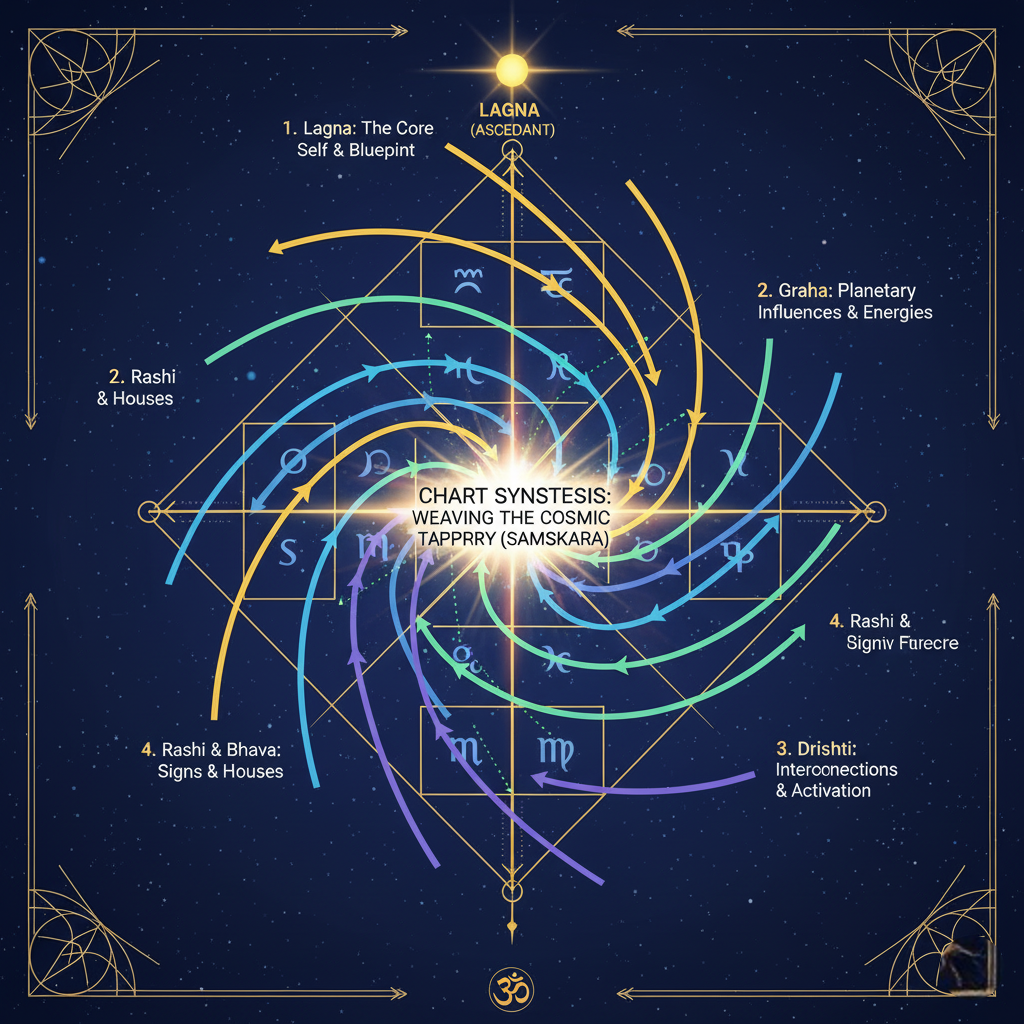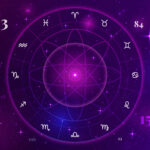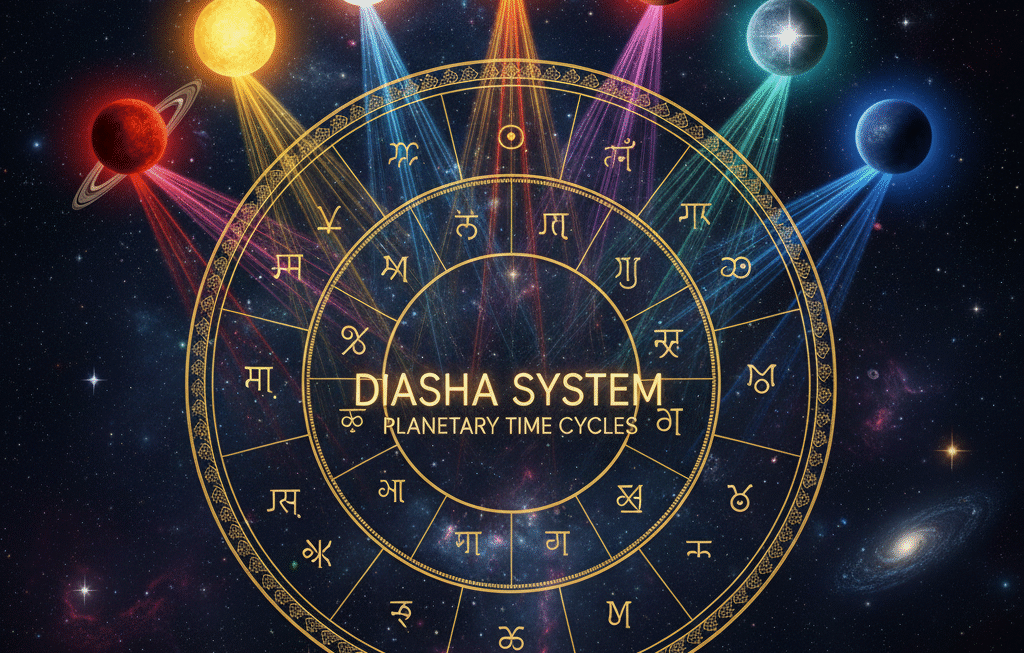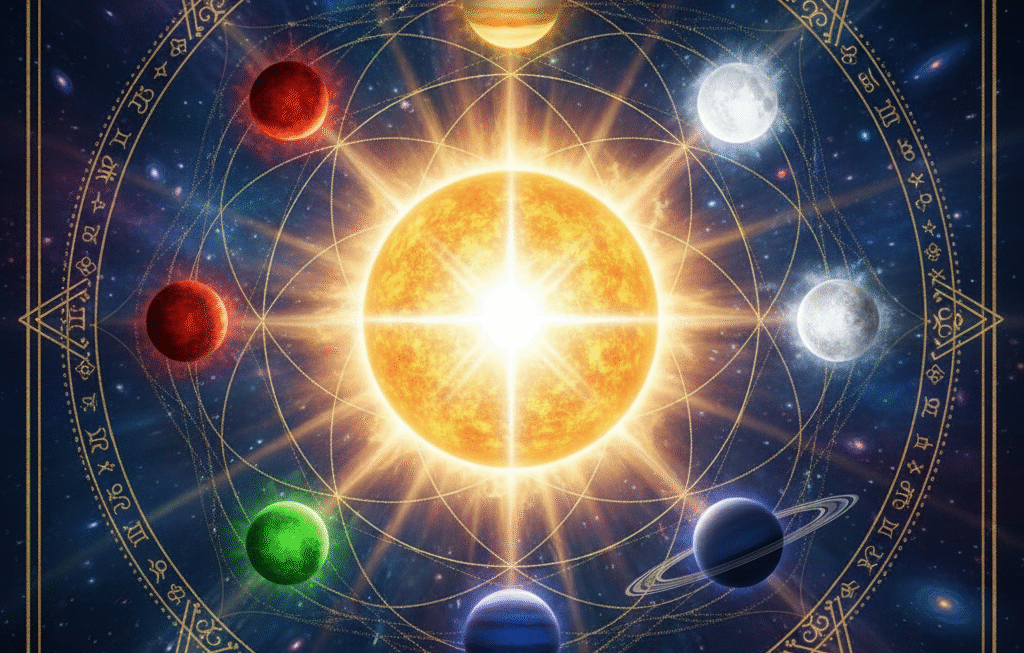You’ve learned about houses, planets, signs, aspects, conjunctions, and dignities. But when you open a full Vedic chart — with all those symbols and numbers — it can still feel overwhelming. How do you connect it all? Welcome to the art of chart synthesis — the process of weaving together all the individual threads of astrology into one meaningful story.
This is where true Jyotish Vedic astrology begins — seeing not isolated pieces, but the living pattern of the soul.
In this step-by-step guide, you’ll learn exactly how to read a full chart like a narrative — from identifying the Lagna (Ascendant) to interpreting planetary relationships and timing periods.
By the end, you’ll know how to bring all chart factors together into a cohesive, insightful reading.
Step 1: Start with the Foundation — The Ascendant (Lagna)
Opinion: The Lagna, or Ascendant, is always the starting point for complete chart analysis.
Reason: It represents you — your physical body, perspective, temperament, and how you approach life. Every other factor in the chart is interpreted from this reference point.
Example: If your Ascendant is Libra, then Venus (its ruler) becomes your chart lord. Venus’s strength, placement, and dignity will tell you how harmoniously your life unfolds.
Restatement: Without anchoring your analysis in the Ascendant, the rest of the chart floats without context.
Action Step:
Open your chart and find the box labeled “As” or the sign rising in the first house. Note its ruler and where that ruler is placed. This is your starting axis — your Lagna-Lord connection.

Step 2: Evaluate the Big Three — Sun, Moon, and Ascendant
Your Sun, Moon, and Rising Sign form the “core triad” — the three lenses through which your identity expresses itself.
- Sun: Represents your ego, vitality, and purpose.
- Moon: Reflects your emotions, mind, and adaptability.
- Ascendant: Shows your body, personality, and outward behavior.
Together, they describe the balance between soul (Sun), mind (Moon), and body (Ascendant).
Mini Exercise:
Write down these three:
- Ascendant Sign
- Moon Sign
- Sun Sign
Then, describe each in one word (e.g., Scorpio – intense, Taurus – stable, Gemini – curious). You’ll start to see your energetic pattern.
Step 3: Examine Each Planet’s Placement by House and Sign
Each planet reveals where and how it expresses its energy.
- By House: Tells you which area of life the planet influences.
- Example: Venus in the 10th → love of art, beauty, or diplomacy in career.
- Example: Venus in the 10th → love of art, beauty, or diplomacy in career.
- By Sign: Describes the quality of its expression.
- Example: Venus in Capricorn → disciplined approach to relationships.
- Example: Venus in Capricorn → disciplined approach to relationships.
- By Dignity: Shows how strong or weak it is — exalted, debilitated, or neutral.
Opinion: Never interpret a planet in isolation.
Reason: Each planet operates through the context of its house, sign, and condition.
Restatement: Only when all three layers are considered does the planet’s true behavior emerge.
Step 4: Identify Relationships — Aspects, Conjunctions, and Dispositors
Now we add the interaction layer — how planets communicate with one another.
Planetary Aspects (Drishti)
Planets “see” or influence specific houses by aspect. Mars, Jupiter, and Saturn have special aspects, while others use the 7th from their position.
→ Example: Jupiter in the 1st aspects the 5th, 7th, and 9th — bringing wisdom and grace to creativity, relationships, and dharma.
Conjunctions (Yuti)
When two or more planets share a house, their energies blend.
→ Example: Sun + Mercury = Budh-Aditya Yoga (intelligence and communication).
But if Sun + Saturn = conflicting energies — ego vs humility.
Dispositors
Every planet “reports” to the ruler of the sign it occupies.
→ Example: Venus in Capricorn → reports to Saturn.
If Saturn is strong, Venus acts maturely. If weak, Venus may struggle.
Opinion: Understanding dispositors is key to chart synthesis.
Reason: It reveals the chain of command within your chart — which planets ultimately guide the others.
Restatement: Strong dispositors mean stable energies; weak ones mean internal conflict.
Step 5: Determine Planetary Strength and Dominance
Now that you’ve identified where planets are and who they interact with, assess who’s in charge.
Factors of Strength:
- Dignity: Exalted, own sign, or Moolatrikona = strong.
- Direction: Planets in their directional strength (Dik Bala) gain power.
- Aspect Support: Benefic aspects enhance; malefic aspects weaken.
- Combustion or Retrograde: Can modify strength — check for proximity to Sun or backward motion.
Action Tip:
List your planets and rate them as Strong, Moderate, or Weak.
This will help you see who’s steering the wheel in your chart.
Step 6: Analyze the House Themes Activated
Each planet rules certain houses — these are the life areas most active in its periods (Dasha).
For example:
- If Mercury rules your 2nd and 11th houses → finances and gains are highlighted.
- If Jupiter rules your 4th and 7th → home and relationships take priority.
Opinion: The ruler-ship tells what kind of events manifest during a Dasha.
Reason: Even a benefic planet can bring stress if it rules challenging houses.
Restatement: Always interpret results through the houses a planet rules, not just where it sits.
Step 7: Blend It All — The Storytelling Stage (Holistic Reading)
This is the heart of chart synthesis — combining all layers into one coherent picture.
Let’s go step-by-step:
- Start from the Ascendant: What is its sign and lord doing?
- Add the Moon: How stable is the mind and emotional world?
- Look at the Sun: What is the person’s purpose and vitality?
- Identify strong/weak planets: Who supports or challenges the chart?
- Note conjunctions and aspects: Where do energies blend or clash?
- Track dispositors: Who’s controlling whom behind the scenes?
- See house patterns: Which areas of life stand out?
- Overlay the Dasha periods: Which planets are currently active?
Now, tell the story —
“This chart belongs to someone with a Libra Ascendant ruled by Venus in the 10th, giving charm and diplomacy in public life. Moon in Taurus strengthens emotional stability, while Sun in the 9th indicates a philosophical, truth-seeking nature. Saturn’s aspect on the Ascendant adds maturity early in life, while Jupiter’s strength in the 11th brings influential friendships. The ongoing Venus Mahadasha activates career growth and relationships — a period of material success and personal refinement.”
That’s complete chart analysis in action.
Step 8: Validate with Current Planetary Periods and Transits
Finally, check timing — which planetary period (Dasha) and current transits are active.
This shows when the patterns you’ve read will unfold.
- The Mahadasha gives the long-term theme.
- The Antardasha adds immediate flavor.
- The Transits (Gocharas) show external triggers.
When all three align with the same house or planet — events manifest clearly.
Step 9: Practice Regularly and Journal Observations
True mastery in chart synthesis comes from repetition and reflection.
🪶 Practical Tip:
- Keep a “Chart Journal” — write notes on people’s charts (friends or family) and compare with real-life traits.
- Track transits and dashas — notice how events correlate.
- Over time, patterns will become second nature.
Opinion: Astrology is not memorization — it’s pattern recognition.
Reason: The more you practice seeing these interconnections, the more intuitive your synthesis becomes.
Restatement: The goal isn’t to recite rules — it’s to see the whole chart as one living organism.
Conclusion: The Art of Seeing the Whole
When you practice chart synthesis, you stop seeing astrology as separate boxes and start reading it as a language of life.
Each planet speaks, each house responds, each sign colors the message.
By connecting them together, you’re not just reading a chart —
you’re reading a soul’s journey.
So next time you open your Kundli, don’t get lost in the details.
Take a breath, step back, and ask yourself:
“What story is this chart trying to tell me?”
That’s when you’ve truly begun your journey into holistic chart reading — the essence of Jyotish.











